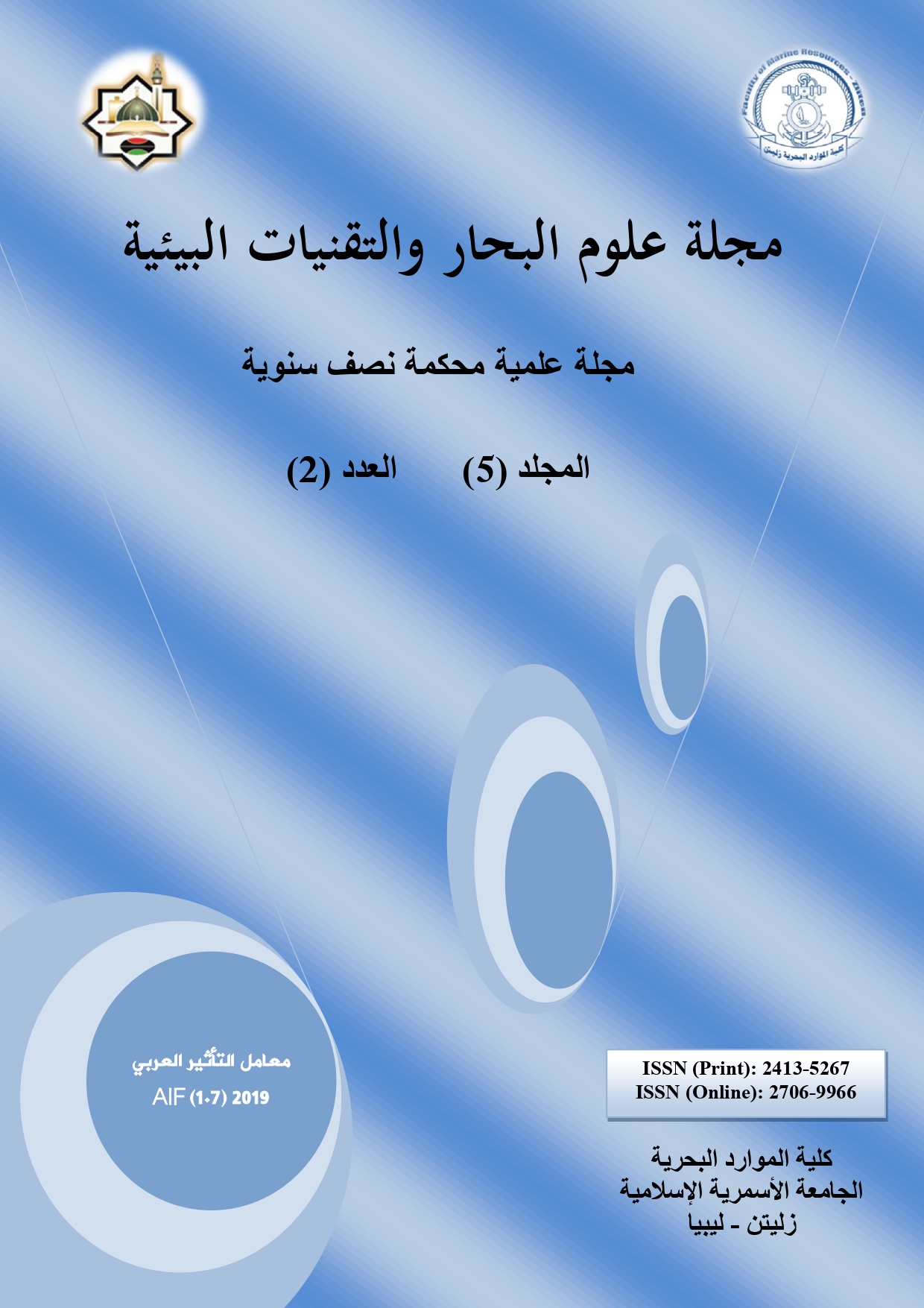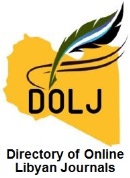دراسة قابلية الأيوض الثانوية لبكتيريا .Bacillus spp على تثبيط تكون الأغشية الحيوية
DOI:
https://doi.org/10.59743/jmset.v5i2.59الكلمات المفتاحية:
الأيوض الثانوية، Bacillus spp، الفعالية التثبيطية، الأغشية الحيوية، المضادات الحيويةالملخص
عزلت 20 عزلة بكتيرية من عينات مياه وترسبات من مناطق مختلفة من محافظة البصرة جنوب العراق، شخصت العزلات شكليا وكيموحيويا وباستخدام نظام التشخيص VITEK II compact الذي اظهر ان هذه العزلات تعود الى نوعين تابعين للجنس Bacillus كما عزلت 5 عزلات بكتيرية تعود لـــــــ5 أنواع مكونة للأغشية الحيوية، ثلاث منها موجبة لصبغة غرام هيStaphylococcus sciuri, Methicillin Resistant Staphylococcus aureus (MRSA), Kocuria kristinae, ونوعين سالبة لصبغ غرام هما Pseudomonas aeruginosa و Escherichia coli.
أنتجت واستخلصت ونقيت الأيوض الثانوية من بكتيريا جنس Bacillus واختبرت فعاليتها التثبيطية ضد البكتيريا الهدف حيث كانت فعاليتها التثبيطية ضد البكتيريا الموجبة لملون غرام اعلى منها ضد البكتيريا السالبة لملون غرام ، فصلت مكونات الأيوض الثانوية باستخدام كروماتوغرافيا الطبقة الرقيقة والتي اظهرت احتواء الأيوض الثانوية على الأحماض الامينية وهذا ما اكده تحليل الأيوض باستخدام جهاز مطياف الكتلة والامتصاص الذري، حددت قيمة البروتينات الكلية في الأيوض الثانوية لتحديد العزلة الأكثر انتاجا للأيوض الثانوية لاختيارها لإكمال الدراسة حيث اختيرت العزلة BS8 وBS14 لإكمال البحث، درس التحديد الكمي للبكتيريا الهدف على تكوين الاغشية الحيوية باستخدام صبغة البنفسجي البلوري حيث سجلت اعلى قيم الامتصاصية لبكتيريا P. aeruginosa، أما اقل القيم فقد كانت لبكتيريا K. kristinae، كما حُددت قيمة التركيز المثبط الأدنى MIC لمستخلصي الأيوض الثانوية.
درس التأثير التثبيطي لمستخلصي الأيوض الثانوية للعزلتين BS8 و BS14 في تكون الاغشية الحيوية في صفيحة المعايرة الدقيقة microtiter plate ومقارنته بالتأثير التثبيطي للمضادين الحيويين حامض النالديكسك والتتراسايكلين إذ لوحظ حدوث انخفاض كبير في النسبة المئوية لتكوين الاغشية الحيوية في بكتيريا P. aeruginosa و S. sciuri عند حضنـــــــــــــــــــها مع المستخلص لاسيمـــــــــــــا عند التركيز الذي يمثل التركيز المثبط الأدنى MIC للمستخلص ضد هذه البكتيريا والتراكيز التي تليه، أما نتائج التأثير التثبيطي للمضادين الحيويين فقد كانت اقل نسبياً من نتائج التأثير التثبيطي للمستخلص ضد البكتيريا الهدف.
التنزيلات
المراجع
Abu Sayem S.M., Manzo E., Ciavatta L., Tramice A., Cordone A., Zanfardino A., De Felice M., and Varcamonti M. (2011). Anti-biofilm activity of an exopolysaccharide from a sponge-associated strain of Bacillus licheniformis. Microbial Cell Factories, 10: 74- 81.
Amin M., Rakhisi Z., and Ahmady A.Z. (2015). Isolation and identification of Bacillus species from soil and evaluation of their antibacterial properties. Avicenna Clin. Microb. Infec., 2(1): 1-4.
Anju K.M., Archana M.M., Mohandas C., and Nambisan B. (2015). Purification and identification of an antibacterial protein from the symbiotic bacteria associated with novel entomopathogenic nematode, Rhabditis (Oscheius) sp. World Journal of Microbiology and Biotechnology, 31(4): 621-632.
Barrios–Gonzalez J., Fernandez F.J., and Tomasini A. (2003). Microbial secondary metabolites production and strain improvement. Indian Journal of Biotechnology, 2(3): 322-333.
Bechard J., Eastwell P.L., Sholberg G., Mazza G., and Skura B. (1998). Isolation and partial chemical characterization of an antimicrobial peptide produced by a strain of Bacillus subtilis. J. Agric. Food Chem., 46(12): 5355- 5361.
Cherif A., Rezgui W., Raddadi N., Daffonchio D., and Boudabous A. (2008). Characterization and partial purification of entomocin 110, a newly identified bacteriocin from Bacillus thuringiensis subsp. entomocidus HD110. Microbiol Res., 163(6): 684- 692.
Choudoir M. J., Pepe-Ranney C., and Buckley D.H. (2018). Diversification of secondary metabolite biosynthetic gene clusters coincides with lineage divergence in Streptomyces. Antibiotics,7(1): pii: E12. doi: 10.3390/antibiotics7010012.
Das P., Mukherjee S., and Sen R. (2008). Antimicrobial potential of a lipopeptide biosurfactant derived from a marine Bacillus circulans. J. Appl. Microbiol., 104(6): 1675–1684.
Delcoue A.H. (2009). Outer membrane permeability and antibiotic resistance. Biochem. Biophys. Acta, 1794(5): 808-816.
Demain A.L., and Fang A. (2000). The natural functions of secondary metabolites. Adv. Biochem. Eng. Biotechnol., 69: 1- 39.
Dusane D.H., Damare S.R., Nancharaiah Y.V., Ramaiah N., Venugopalan V.P., Kumar A.R., and Zinjarde S.S. (2013). Disruption of microbial biofilms by an extracellular protein isolated from epibiotic tropical marine strain of Bacillus licheniformis. PLoS One, 8(5): 1-12.
Dusane D.H., Pawar V.S., Nancharaiah Y.V., Venugopalan V.P., and Kumar A.R. (2011). Antibiofilm potential of a glycolipid biosurfactant produced by a tropical marine strain of Serratia marcescens. Biofouling, 27(6): 645–654.
Gordillo M.A., and Maldonado M.C. (2012). Purification of peptides from Bacillus strains with biological activity. Chapter 11, pp: 201-224. In: Chromatography and its applications. Dhanarasu, S.(ed.). Publisher InTech. ISBN: 978-953-51-0357-8
Laemmli U.K. (1970). Cleavage of structural protein during the assembly of the head of bacteriophage T4. Nature, 227(5259): 680-685.
Leifert C., Li H., Chidburee S., Hampson S., Workman S., Sigee D., Epton H., and Harbour A. (1995). Antibiotic production and biocontrol activity by Bacillus subtilis CL27 and Bacillus pumilus CL45. J. Appl. Bacteriol., 78(2): 97-108.
Leiman S.A., May J.M., Lebar M.D., Kahne D., Kolter R., and Losick R. (2013). D-amino acids indirectly inhibit biofilm formation in Bacillus subtilis by interfering with protein synthesis. J. Bacteriol., 195(23): 5391–5395.
Liu Z., Wang Y., Jia X., and Lu W. (2018). Isolation of secondary metabolites with antimicrobial activities from Bacillus amyloliquefaciens LWYZ003. Transactions of Tianjin University. Published online:19 February2018,7p https://doi.org/10.1007/s12209-018-0137-7.
Mannerat S., and Phetrong K. (2007). Isolation of biosurfactant – producing marine bacteria and characteristics of selected biosurfactant. Songklanakarin J. Sci. Technol., 29(3): 781-791.
Marhaeni B., Radjasa O.K., Khoeri M.M., Sabdono A., Bengen D.G., and Sudoyo H. (2011). Antifouling activity of bacterial symbionts of sea grasses against marine biofilm-forming bacteria. Journal of Environmental Protection, 2(9): 1245-1249.
Mohan G., Kumar A., Thangappanpillai T., and Ramasamy B. (2016). Antimicrobial activities of secondary metabolites and phylogenetic study of sponge endosymbiotic bacteria, Bacillus sp. at Agatti Island Lakshadweep Archipelago. Biotechnol. Reports, 11: 44- 52.
Mondol M., Shin H., and Islam M. (2013). Diversity of secondary metabolites from marine Bacillus species: Chemistry and biological activity. Mar. Drugs, 11(8): 2846–2872.
Motta A.S., Cannavan F.S., Tsai S.M., and Brandelli A. (2007). Characterization of a broad range antibacterial substance from a new Bacillus species isolated from amazon basin. Arch. Microbiol., 188: 367–375. doi:10.1007/s00203-007-0257-2.
O'Toole G.A. (2011). Microtiter dish formation assay. Journal of Visualized Experiments, 47: 1-2.
PHE: Public Health England (2015). UK standards for microbiology investigation; identification of Bacillus species. 3: l- 27.
Pincus D.H. (2005). Microbial identification using the VITEK® 2 bioMérieux system bioMérieux Hazelwood. MO, USA.
Priest F., Aquino de Muro M., and Aji D. (1995). Systematics of insect pathogenic Bacilli uses in strain identification and isolation of novel pathogens. p: 275- 295. In: Bacterial Diversity and Systematics. Priest F., Ramos-Cormenzana A., and Tindaall B. (eds.). Plenum Press, New York, USA.
Ramyabharathi S.A., and Raguchander T. (2014). Efficacy of secondary metabolites produced by Bacillus subtilis EPCO16 against tomato wilt pathogen Fusarium oxyporum f. sp. lycopersici. Journal of Mycology and Plant Pathology, 44(2): 148-153.
Sanchez C.J. Jr., Mende K., M.L., Akers, K.S., Romano, D.R., Wenke, J.C., and Murray, C.K. (2013). Biofilm formation by clinical isolates and the implications in chronic infections. BMC Infect. Dis., 13(1): 47.
Sawale A., Kadam T.A., and Karale M.A. (2014). Antimicrobial activity of secondary metabolites from halophilic Bacillus pumilus sp. Int. J. Current Microbiol. Appl. Sci.,3(6): 506-512.
Sharma P. K., Goel M., Dureja P., and Uniyal P.L. (2010). Isolation and identification of secondary metabolites from hexane extract of culture filtrate of Bacillus lichniformis MTCC 7445. Archives Phytopathol. Plant Protection, 43(16): 1636-1642.
Skariyachan S., Rao A.G., Patil M.R., Saikia B., Bharadwaj K.N.V., and Rao J.S.G. (2013). Antimicrobial potential of metabolites extracted from bacterial symbionts associated with marine sponges in coastal area of gulf of Mannar Biosphere, India. Letters in Applied Microbiology, 58(3): 231-241.
SPSS: Statistical Package for Social Sciences (2009). Statistical package for windows. Ver.17.0, Chicago, SPSS, Inc.
Sriram M.I., Kalishwaralal K., Deepak V., Gracerosepat R., Srisakthi K., and Gurunathan S. (2011). Biofilm inhibition and antimicrobial action of lipopeptide biosurfactant produced by heavy metal tolerant strain Bacillus cereus NK1. Colloids and Surfaces B: Biointerfaces, 85(2): 174-181.
Teasdale M.E., Liu J., Wallace J., Akhlaghi F., and Rowley D.C. (2009). Secondary metabolites produced by the marine bacterium Halobacillus salinus that inhibit quorum sensing-controlled phenotypes in gram-negative bacteria. Applied and Environmental Microbiology, 75(3): 567–572.
Teixeira M.L., Rosa A.D., and Brandelli A. (2013). Characterization of an antimicrobial peptide produced by Bacillus subtilis sub sp. spizezinii showing inhibitory activity towards Haemophilus parasuis. Microbiology,159(Pt 5): 980- 988.
Valle J., Re S.D., Henny N., Fontaine T., Balestrino D., Latour-Lambert P., and Ghigo J.M. (2006). Broad- spectrum biofilm inhibition by a secreted bacterial polysaccharide. PNAS, 103(33): 12558-12563.
Wiener M.C., and Horanyi P.S. (2011). How hydrophobic molecules traverse the outer membranes of gram-negative bacteria. Proc. Natl. Acad. Sci. USA., 108(27): 10929-10930.
Wilson G.S., Raftos D.A., and Nair S.V. (2011). Antimicrobial activity of surface attached marine bacteria in biofilms. Microbiol. Res., 166(6): 437-448.
Yan Q., Lopes L.D., Shaffer B.T., Kidarsa T.A., Vining O., Philmus B., Song C., Stockwell V.O., Raaijmakers J.M., McPhail K.L., Andreote F.D., Chang J.H., and Loper J.E. (2018). Secondary metabolism and interspecific competition affect accumulation of spontaneous mutants in the GacS-GacA regulatory system in Pseudomonas protegens. MBio, 9: e01845-17.
Yaryura P.M., Leon M., Correa O.S., Kerber N.L., Pucheu N.L., and Garcia A.F.) 2008(. Assessment of the role of chemotaxis and biofilm formation as requirements for colonization of roots and seeds of soybean plants by Bacillus amyliquefaciens BNM 339. Curr. Microbiol., 56(6): 625- 632.
التنزيلات
منشور
إصدار
القسم
الرخصة
الحقوق الفكرية (c) 2019 مجلة علوم البحار والتقنيات البيئية

هذا العمل مرخص بموجب Creative Commons Attribution 4.0 International License.












